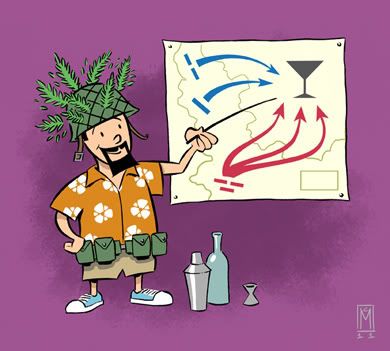Monday, June 27, 2011
Tales of the Cocktail: Preemptive Strike (Part 5)
Rolling along with the pre-Tales "Cavalcade of Booze Knowledge" (tm) I got the chance to grill Christine Sismondo on her presentation "The Bad Boys of Saloons.''
If you don't know Christine, she's the author of America Walks into a Bar: A Spirited History of Taverns and Saloons, Speakeasies and Grog Shops, as well as Mondo Cocktail: A Shaken and Stirred History. She also contributes drink columns for Report on Business and Eye Weekly magazine. She kindly let me toss a few questions her way regarding her upcoming seminar.
What were the main characteristics that distinguished these types of places from their more upmarket counterparts?
There was an "anything goes" ethic in play. The main idea was to do whatever it took to get patrons in the door and keep them there. Many of the drinking establishments during this period (the 1850's-1900's) were what were called "tied houses", which meant they were affiliated with a particular beer company. Due to the exclusive nature of their relationship with one specific brewer, their profit margins were very low, so there were a lot of frauds and scams happening in order to boost the bottom line.
What were some of the drinks commonly found in these places?
In addition to whatever the house beer was, there were a lot of drinks that were basically un-aged white whiskey with other things added to make them palatable. These could contain a multitude of flavoring agents as well as drugs like camphor, for instance.
Can you describe the types of people who frequented these types of bars?
There was a popular perception that these types of places catered to the worst people engaging in the worst drinking behavior. The impression was that it was just immigrants getting plastered, and that dovetailed with the general demonizing of whatever the most recent wave of "just-off-the boat" people was. The truth is that you were just as likely to encounter questionable behavior and poor drinking habits in the upscale bars. As a matter of fact, you were quite likely to find well-heeled citizens slumming in these places, but that's a story unto itself.
What prompted the creation of these types of establishments? Was it simply an attempt to offer cheaper booze and undercut the competition?
The thing to keep in mind is that everyone was in the booze business during this time period. Grocery stores, pharmacies, soda fountains, and almost any merchant you can think of sold some type of alcohol. In the 1840's the average person drank twice as much alcohol as today. It was part of daily living, and was considered good for you. With that kind of consumption, the demand for booze was high, and sales were unregulated as well. The result was a tavern, grog shop, or liquor vendor within easy reach almost anywhere.
Could you find these places in almost any city or town? How widespread were they?
There were times where cities or counties would go dry, but even then there were ways to get booze to the public. It was pretty commonplace, even in places where the law stipulated there was to be no liquor sold.
Due to their illicit nature, were these places able to weather prohibition any better than the higher-profile reputable joints?
These places were generally fly-by-night joints, so they were used to being under constant threat of shutdown. Since they were accustomed to closing and reopening at a moment's notice , prohibition really didn't impact them...although everyone was forced to get creative during that time.
"The Bad Boys of Saloons" happens from 3:00 pm to 4:30 pm July 21 in the Queen Anne Ballroom at the Hotel Monteleone. Go here to purchase tickets.
Subscribe to:
Post Comments (Atom)



0 comments:
Post a Comment